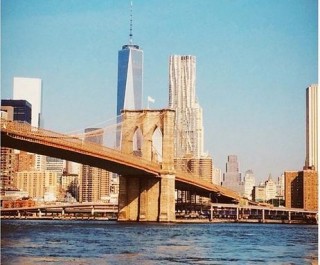A Battlefield Where Speed Is Everything
by Awl Sponsors
They can accelerate faster than a Ferrari, strike with 10 times the g-force of a space shuttle, and outmaneuver a fighter jet. Whether the battlefield is the dark underworld of the forest, the bizarre netherworld between the river and the ocean, or the scorching hot Namib Desert, Smithsonian Channel’s second season of Speed Kills follows the world’s fastest predators as they use their incredible speeds for lethal means.
Check out the video above for a glimpse of how Speed Kills uses high-speed cameras that capture every movement in high definition, at 1,000 frames-per-second, so you won’t miss one graphic detail of this fast-paced and often violent world.
For more freakish assassins that can strike in the blink of an eye, watch the season premiere of Speed Kills on Wednesday, August 20 at 8PM ET/PT on the Smithsonian Channel.
Some Things I Will Miss About Brooklyn
by Chris Arnade
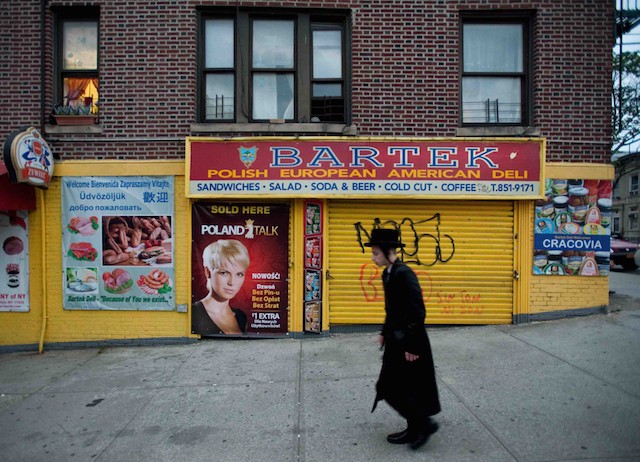
On my first day in Brooklyn, twenty-one years ago, I took the subway from my neighborhood, Brooklyn Heights, to its terminus at the tip of Coney Island. I walked the ten miles back, slowly weaving my way through a loose confederation of neighborhoods, held together by subways and buses. Statistically, since then, Brooklyn has changed for the better: It is safer. It is cleaner. But its bumps and edges, the defining features of those neighborhoods, have been smoothed and polished away into an increasingly continuous, glossy surface known as “Brooklyn.” Now I’m leaving.

Pigeon Keepers of Bushwick and East NY
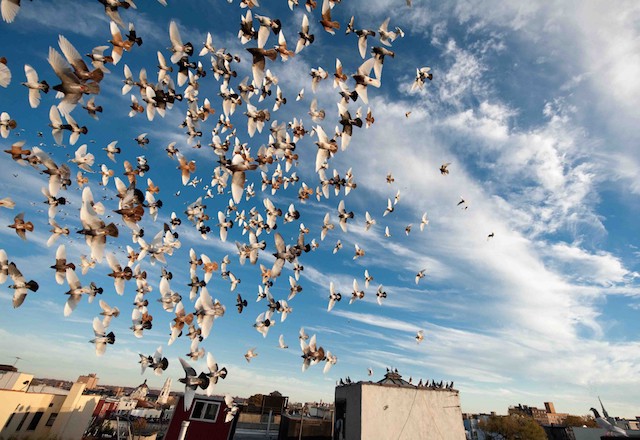
(Pigeons over Bushwick)
On most afternoons, flocks of pigeons swarm above Maria Hernandez Park in Bushwick. They’re owned by pigeon keepers, who breed and tend to them on nearby rooftops. The practice, part sport, part art, was first brought over by Italians in the early 1900s. At one point, well over a thousand men in Brooklyn kept pigeons. About a hundred such keepers are left — mostly Dominican and Puerto Rican men, primarily in Bushwick and East New York. You find them on whichever roofs they can use. A few are lucky enough to own their building, or are supers in buildings with roof access. Most, however, find abandoned buildings with unclaimed roofs and turn them into pigeon homes.
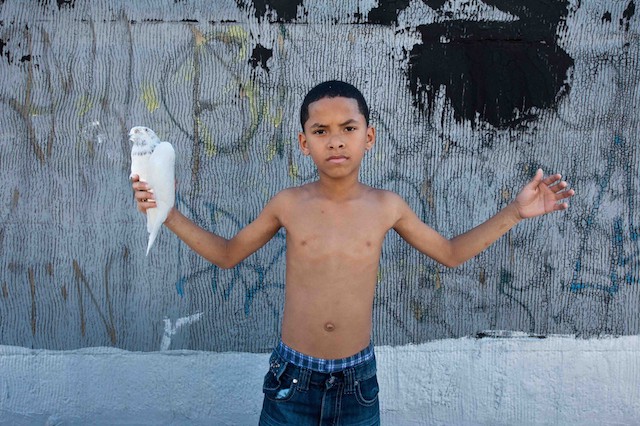
(Young Pigeon Keeper, Bushwick)
The keepers’ stories are almost always the same: Everyone starts young; everyone comes from a rough neighborhood; the birds keep them out of trouble. “I would be dead now if not for my birds. Dead,” Whitey, a pigeon keeper, told me. “So many of my friends are. Birds, they kept me on the roof and out of trouble.”
Kevin, a childhood friend of Mike Tyson’s, started keeping pigeons at eight, while growing up in East New York. “I have had a few problems. Growing up here it’s hard not to, but that’s all behind me now,” he said. “God is now shining his light on me. For the last fiteen years I have stayed away from everything. Now I spend my evenings on the roof with my birds. The pigeons don’t talk back to you and my wife always knows where I am. I can put everything behind me when I am up on the roof.”
Slice was a drug dealer when, at seventeen, he killed another dealer and spent twenty years in jail. Now he is “locked down by my wife and birds. Both of them keep me out of trouble,” he said. “When I am up here on the roof, I am in another world. I can leave all the past behind. All that below us, that’s gone.”

Soccer Tavern, Sunset Park
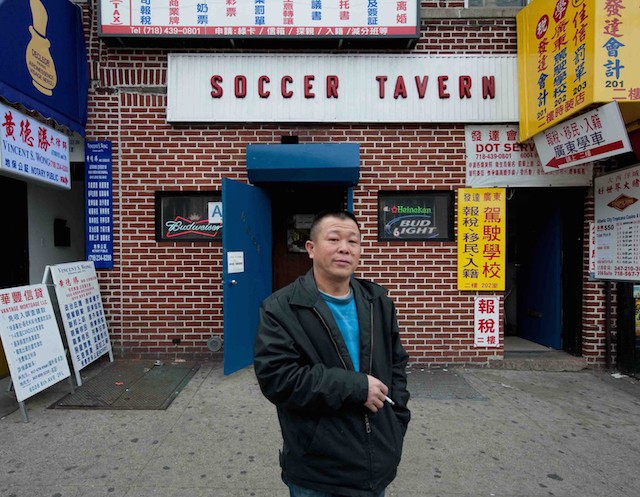
(Regular in front of bar)
Sunset Park was once filled with Norwegians and other Northern Europeans who immigrated to work the docks along the Brooklyn waterfront. That ended after 1969: The docks started closing, and Norway found oil. Now the neighborhood, especially around Soccer Tavern’s home on Eighth Avenue, is predominately Chinese.
The Soccer Tavern, founded in 1932, is the only straggler left from that period. It is the single business on a stretch of fifteen blocks not dominated by or directed at the Chinese population. Across the street from the bar is a market that takes up the entire block, selling, amongst other things, live bullfrogs.
The bar seats are usually occupied by older residents who moved to Sunset Park long ago from Norway, Germany, Austria, and other parts of Europe. Some of them are very old, and very fond of drink. “This is my nursing home,” said Mary. “If I get too drunk Jimmie knows how to make sure I get home.”
A large group of Chinese regulars drink bottles of Budweiser and eat one-dollar sticks of roast meat from a vendor outside in one corner of the bar, clustered around a few tables. Some of the European regulars are not entirely comfortable with them: “This neighborhood isn’t the same,” said a younger man. “My friends started leaving and those guys started coming into our country.”
“There used to be six bars on this stretch, all filled,” Jimmy, the Irish owner of the Soccer Tavern, told me. “Now this is the only one. I have only survived because of my Chinese customers. They are great. I run the only Chirish bar in all of New York.”
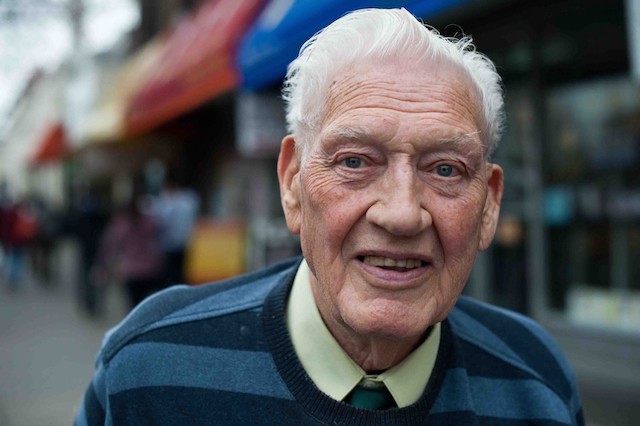
(Vidar)
The oldest regular, Vidar, is eighty-nine and had his first drink in the Soccer Tavern in 1943. He had left Norway on a whaling ship at the age of fifteen, just prior to the start of World War II. Unable to return because of the war, he joined the Merchant Marines, working as a gunner on cargo ships plying the North Atlantic. He survived being sunk four times. He once spent five days in a life raft. When his ships docked in Brooklyn, he and his friend would walk up the hill towards Eighth Avenue to drink in bars like the-then newish Soccer Tavern. After the war, he immigrated to Sunset Park where he found jobs on fishing boats. A hurricane in 1956 led to another rescue at sea. “That was enough,” he told me. “I moved to working on tug boats.” He retired in 1983. He recently was awarded the St. Olaf’s medal by the King for his service to Norway during the war.

Floyd Bennett Field

(Children posing with RC plane)
Floyd Bennett Field was New York’s first municipal airport. Later, it was a naval air station. Now it’s a large park used by a collection of the oddly obsessed who need large swaths of empty, flat concrete, like the radio-controlled car and truck guys, who race tiny vehicles down an old runway. In one hand, they twiddle a remote control and in another they hold a joint or a beer. They obsess over fine-tuning their little engines, revving them up to high pitches and clouds of smoke. Indifferent women stand aside, trying to keep the smaller kids from getting in the way. “If this is what makes him happy. I’m just glad he isn’t racing real cars.”
Miniature planes, each lovingly crafted, use another patch of old runway. The small planes, controlled by a group with more elaborate radio controllers, accelerate down the runway before lifting off, banking over the radio controlled cars and then over the marshes, like a tiny homage to the old airfield.
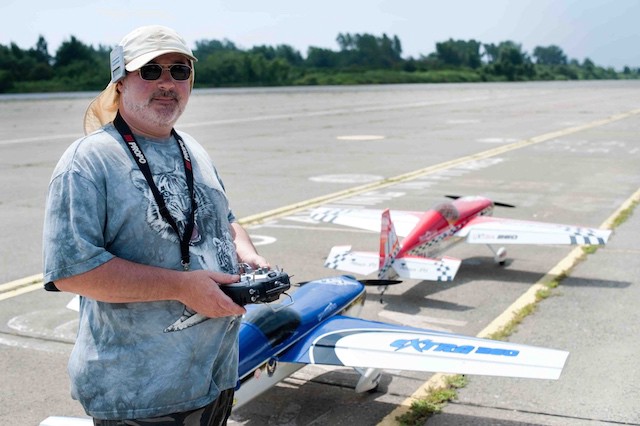
(Preparing to take off)
A small viewing stand, seemingly dragged from a little league baseball field, sits next to the runway, filled with the families of the pilots and the curious. A Hasidic man, trying desperately to keep his kids entertained, tested them on their ability to recognize the different planes: “That’s a Fokker triplane, circa 1917.” The kids ask for ice cream.
Another old runway is used to train sanitation workers to drive the massive trucks. NYC garbage trucks circle around and around, almost as if playing a slow motion, inertia-intense, game of tag. NYPD helicopters use another as a storage facility and landing pad. Scattered across the park are old massive hangers, some repurposed as sports complexes. The others sit behind fences, ever so slowly collapsing back into the ground. A husband taught his wife how to parallel park; a solitary man hit golf balls into the bay. Another man tried to teach his girlfriend how to kiss; well, that’s what it looks like, at least.

Open hydrants, all of Brooklyn
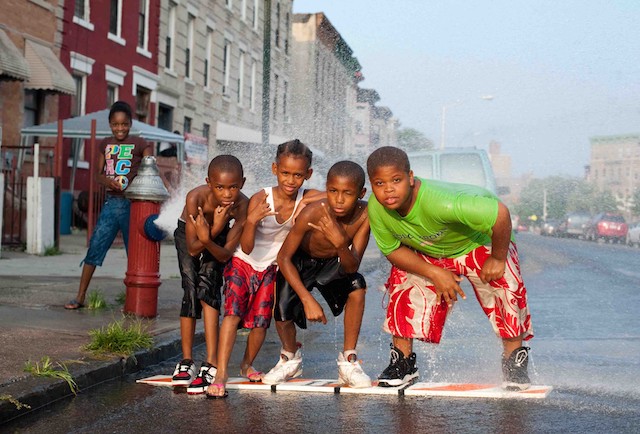
(Children in East NY street surfing)
The streets are the only summer home for much of Brooklyn. As the heat intensifies, apartments disgorge their residents and the hydrants are opened — legally, by having a spray cap installed by the fire departments, or otherwise, since on almost every block someone owns a gigantic wrench.
Mothers wash their smaller children in buckets filled from the hydrants. Others march their children out in bathing suits with soap and shampoo. Passing drivers slow down, and steer their cars slowly through the spray, turning around to clean both sides. A broken table turned upside down and bent, placed inches from the spray, shoots the water in an arc that reaches across the street and into a basketball court. A thick plastic tarp is laid across the street, slicked with water and dishwashing liquid, and turned into a giant slip and slide.
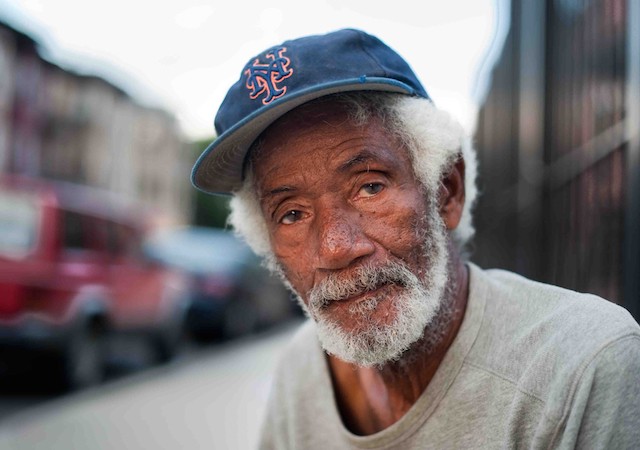
(George)
On one block, where kids have set up an old police barricade to surf on, George, who is eighty-five, came out of the broken motor home he lives in, windows clouded over with piles of junk. Originally from Honduras, he worked on freighters in the Caribbean his entire life before retiring in Brooklyn. He sat in a chair and watched the children. “I do miss being young, but I don’t mind being old, because when you get to be my age, whatever regrets you may have are hard to remember,” he told me.
As midnight approached, police in cars broke up the crowds and told the children to go home. The water ran down the street into the corner gutters that collected the afternoon’s detritus: beer cans, vodka bottles, ice cream wrappers, potato chip bags, and a few stray condoms.

Sunset at Sunset Park in Sunset Park
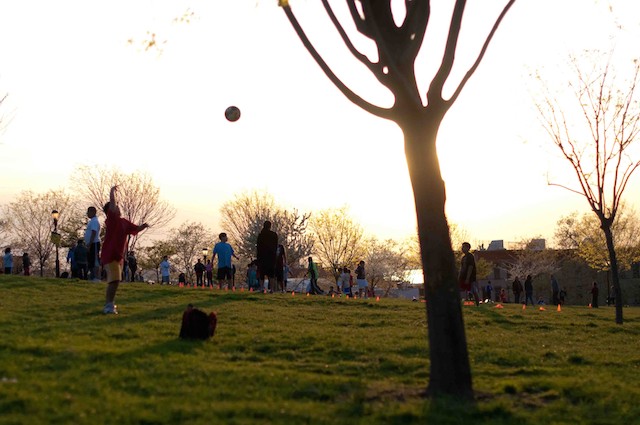
Sunset Park, the neighborhood, is named after Sunset Park, the park, which is a wonderful place to watch a sunset. Roughly the size of four square city blocks, the park is centered on a ridge that faces west towards the water of New York harbor. The park is pitched downwards, sloped in its lower half at an angle like a movie theater. At the top of the park, where it flattens, is a huge municipal pool, and sprinklers, and volleyball courts, and playgrounds, and basketball courts, and soccer pitches.
The neighborhood is divided roughly in two : From the water to Fifth Avenue is mostly Mexican and Central Americans; from Sixth to Twelfth Avenues is mostly Chinese. The park is a seam connecting the two very different cultures that live together because of a shared need for affordable rent. On summer afternoons, it feels as if the entire neighborhood unites in the park. Solitary boom boxes blast high-pitched music not meant for blasting: Chinese women dance ever so slowly, while Mexican families picnic to Tejano music. Women selling mangos on sticks jingle tiny bells. Children — playing soccer, or tag, or volleyball, or flying kites, or skateboarding — yelp.

Oneg Heimishe Bakery, Williamsburg
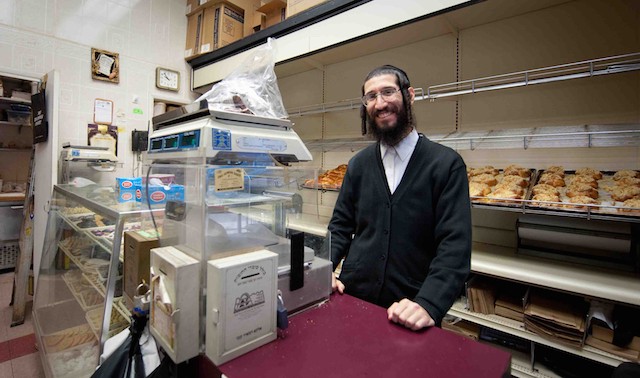
(Baker at Oneg Heimishe)
The insular Satmar Hasidic community of Williamsburg has few obvious offerings for visitors. There are wig stores for the ladies, with strict rules about the presence of men. There are Shtreimel stores for men, selling the large cylindrical fur hats that are worn on Shabbat and Jewish holidays, the ones that look like chocolate cakes. The corner stores, Satmar bodegas, sell Mayim Chaim Cola rather than Coke, as well as other kosher replacement products. Buying a Shtreimal is restricted to the Satmars; buying a Mayim Chaim Cola is not.
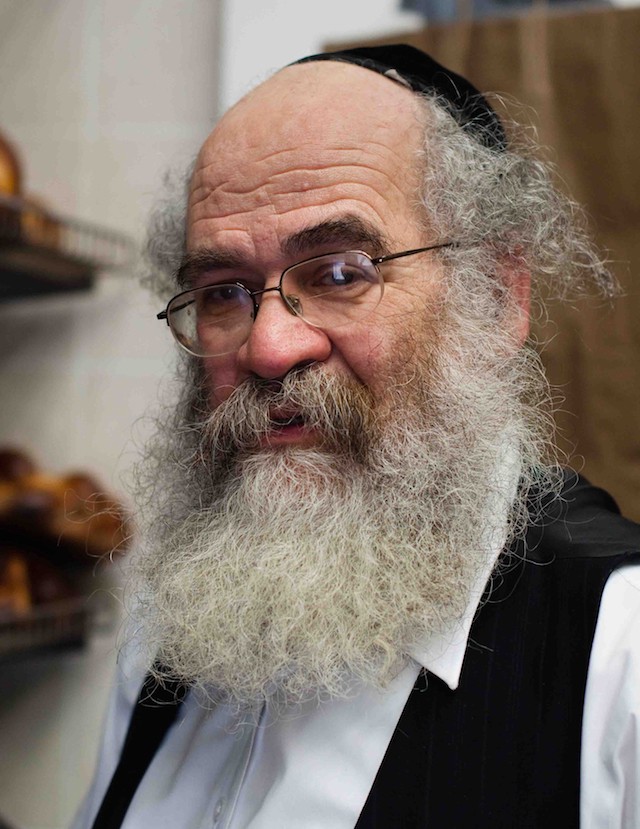
(Baker)
At the far end of the neighborhood’s busiest street, at 188 Lee Avenue, the Oneg Heimishe Bakery offers something that anyone would want: the city’s best chocolate bread. Made fresh each morning, it’s almost always sold out by afternoon. Early in the morning, when the bread is still hot, the chocolate inside oozes and drips. It’s served wrapped tightly in wax paper and a brown paper bag.
The Oneg Heimishe Bakery isn’t open on Saturdays or on Jewish holidays, high or low or in between, of which there are many. It isn’t open now, or any time during the summer, because the family that runs it moves upstate to Sullivan County, like many Satmars do. There are other bakeries in the neighborhood that don’t close during the summers, that have longer hours, but as their owners admit, “Oneg Heimishe has the been doing it the longest.”
At the other end of Lee Avenue, toward the water, where it runs into Division Avenue, huge towers of low-income housing, occupied by mostly Satmar families, surround small parks, like the Roberto Clemente ball field. Kids fill the park, running around playing tag. When I asked one of them, “Who is Roberto Clemente?” they shrugged.
“He was a famous baseball player,” I said.
The children asked back, in unison, without irony, “What is baseball?”

Bait and Tackle bar, Red Hook
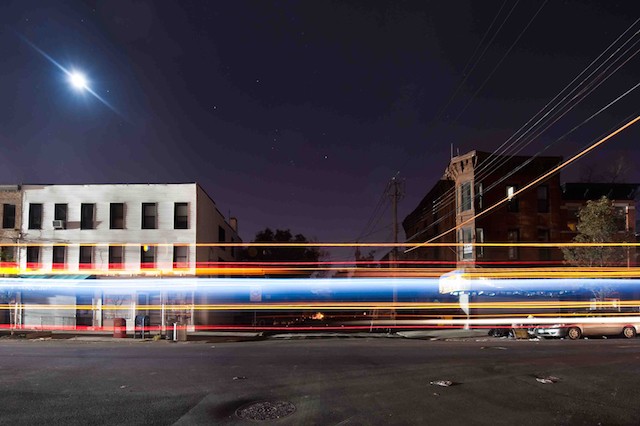
(Looking out from Bait and Tackle at Red Hook)
Because Red Hook is severed from the rest of Brooklyn by the BQE, the difficulties of the borough during the sixties, seventies, and eighties, hit it as hard as any other neighborhood. Now, the recent upswing in Brooklyn, shifting into euphoria, has been slower to make its way to Red Hook. Rising rents haven’t yet pushed out all the working artists. Co-ops haven’t entirely replaced working industry, and the few destination restaurants, serving whatever the fuck is in vogue, still have much of the neighborhood in them.
Visitors to Red Hook, attracted by the views and the newer restaurants, or brought in by a perverse desire to make a day of IKEA, generally make their way to Sunny’s Bar, drawn by its impressive history, and by the guidebooks.
Bait and Tackle bar doesn’t get that attention, partly because it doesn’t have the history — it’s only only ten years old, not, like, a hundred. It does have everything a great bar needs: A genuine feel, cheap drinks, interesting regulars who are in fact slightly irregular, forgiving bartenders, an Irish owner, great music, enough quiet to have a real conversation, and long hours.
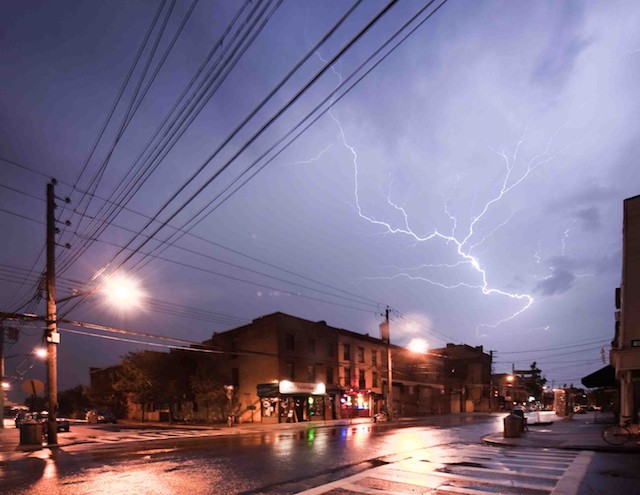
(Bait and Tackle during storm)
It is also very much part of the neighborhood. The night that Hurricane Sandy hit, one of the owners, Barry O’Meara, stayed in the bar as the water edged higher, trying to rescue as much as possible. “I really didn’t have a choice,” he told me. After Sandy flooded Red Hook and sent water over the top of Bait and Tackle’s bar, O’Meara and some of his regulars worked together to re-open within days. For the next few months, as crews worked on restoring power to the neighborhood, Bait and Tackle, with the help of generators, became an unofficial community center — one of the only bright spots in otherwise dim neighborhood.

Yemeni restaurants, Cobble Hill
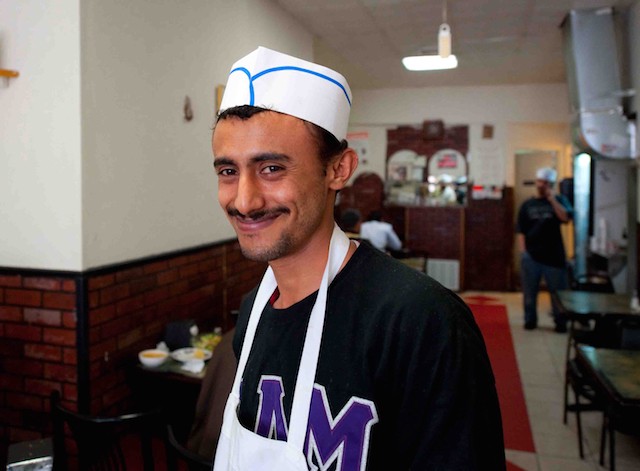
(Waiter, Yemen Cuisine)
Atlantic Avenue, especially near its intersection with Court Street, has long been a center of Middle Eastern culture in New York City. Once primarily Syrian and Lebanese, over the last thirty years it has become equally Yemeni. An influx of a particular ethnic group is sometimes a sign of bad things back home; in Yemen, one the poorest Middle Eastern countries, a long and violent conflict between the south and north has left the economy in disarray.
Three Yemeni restaurants are clustered on the same block as a newish Trader Joe’s: Hadramout Restaurant at 172 Atlantic, Yemen Café at 176, and Yemen Cuisine around the corner at 145 Court Street.
Yemen Café, up a flight of stairs, is the oldest, and also the most comfortable for the Trader Joe’s crowd. It is well lit, well acquainted with US tastes, and fluent in English.
Hadramout, down a flight of stairs, is less so. It is harshly lit, with schoolroom-like tables littered with newspapers in Arabic. A TV in the corner, above the self-serve tea table, runs continual loops of Middle Eastern news. It serves Yemenites almost exclusively, and at times stays open until 6 am for the late night workers; other times, it stays closed for long stretches.
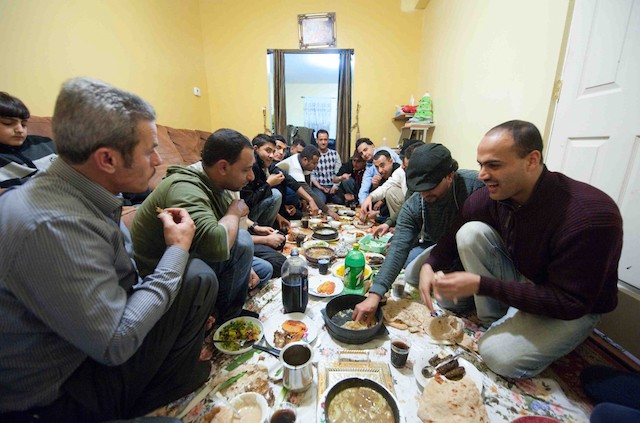
(Gathering at friends house)
Over the last twenty years, Yemenites have started buying many of the bodegas in Brooklyn, especially in the remaining un-gentrified neighborhoods. Many owners keep their stores open until midnight and then come to Hadramout for a meal — stews, large metal platters of meat (mostly lamb), and hot, fresh flat bread with sweet, milky tea — before going home. “We come to talk politics, business, to gossip,” Mohammed told me. “Many of us are related, we all try to help each other. Running stores. It is not very easy. It requires the whole family to work. I take my kids to Yemen every other summer. But I don’t want them to be Yemeni. I want them to be American. To be Yemeni only in spirit. To be faithful to the religion, the food, but not the craziness.”
When they leave, often after midnight, they pass two huge dumpsters on the sidewalk in front of Trader Joe’s, filled with bags and bags of food beyond its expiration date. Sometimes young Brooklynites, Freegans, climb out of the dumpsters, holding the bags.

Tatiana Restaurant, Brighton Beach
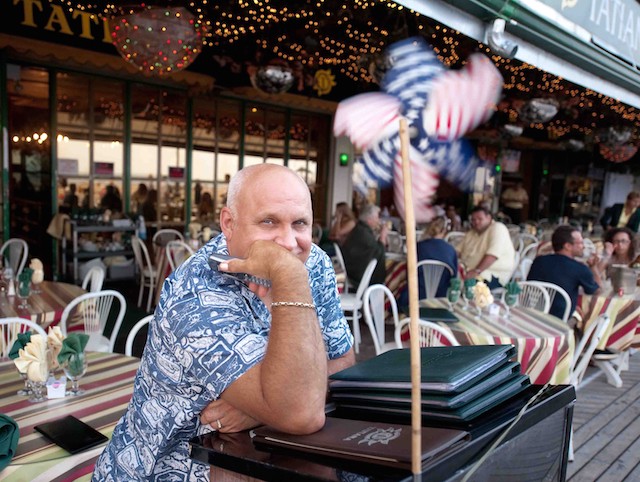
(Host, Tatiana Restaurant)
The Russian speakers who first settled in Brighton Beach — mostly Jewish refugees from Ukraine back in the nineteen fifties — couldn’t believe their luck. “Such a beautiful location, and nobody but us and the poor seemed to want to live here. The beach is better than the Black Sea, and the weather warmer than Kiev,” said Ivan.
Brighton Beach is fully formed. Newer immigrants still come; they are often from Russia and Ukraine or places close to it, like Azerbaijan or Tajikistan. Everyone speaks Russian. The usual pattern of immigration — first wave moves into neighborhood, gets wealthier, moves out, hasn’t fully played out in Brighton Beach. “I am not moving,” said Sonya, I am happy here. I have everything I could want.”
Brighton Beach is a beach town in more than just name; much of the neighborhood’s life is played out along the wooden boardwalk. When the summer brings in the rest of New York, or at least those without access to cars and second homes, the boardwalk seems to change its identity, with other languages mixed in with Russian. It reverts when the sun sets. Families come down from the apartments that hover over the boardwalk to eat and celebrate at the outdoor tables of the restaurants lining it. Of all of them, Tatiana’s is the largest and best.
Even in the fall and winter, when the visitors have left, families still gather to celebrate underneath Tatiana’s large green tent on the boardwalk. When the night turns cold, the waiters and waitresses offer guests blankets, wrapping them around their shoulders. Platters of food, all huge portions, come in waves: smoked fish, soups, and seafood. Vodka and water are consumed in almost equal measure. Between courses, smokers lean against the boardwalk railing, across from the restaurant, looking off to the ocean.
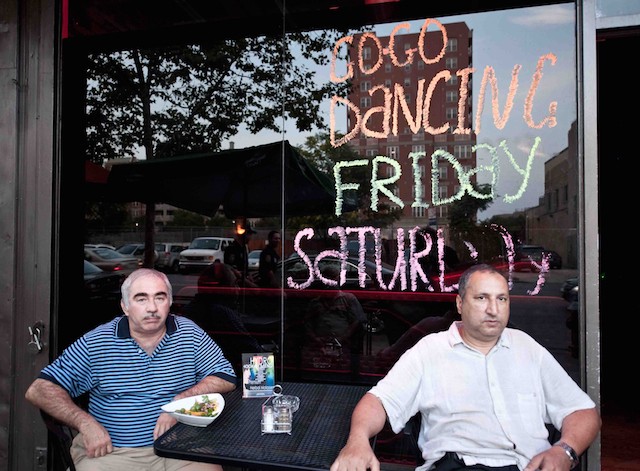
On a cool fall Sunday night in October, next to Tatiana’s, a group of students hung a white blanket on a wall. Plastic chairs were dragged out, and a Russian art movie played onto the blanket; gusts of wind distorted the movie just a bit. An older man, taking a smoking break, stopped to watch the film. One of the students offered him a hit from a joint. He waved his hand no and disappeared, only to return later with a bottle of Vodka. He handed it to the students, smiled, and went back to join his family for dinner.

Walking across the Brooklyn Bridge
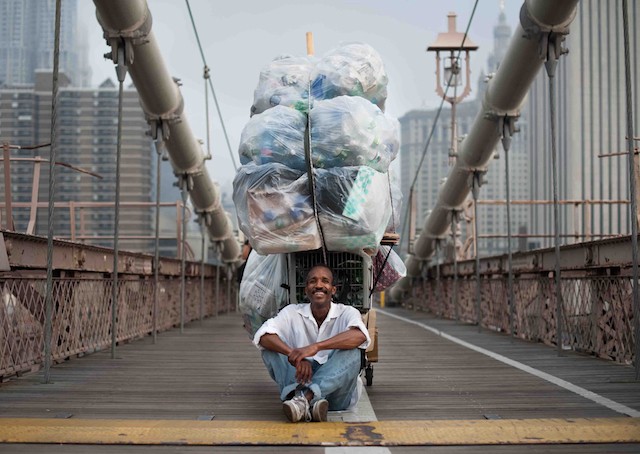
(Michael, coming home)
Before Brooklyn became a brand, the Brooklyn Bridge, to most, represented Brooklyn. Tourists would walk the pedestrian walkway, along a bouncy wooden track riding between two gently arced cables, up to the apogee, stop, take pictures that have been taken a million times before, and then walk back to Manhattan, determined to get back in time to shower and dress before their Broadway show began.
The few who walked the entire length were almost always from Brooklyn: People commuting very early in the morning or late in the evening. The commuters were a small group that rarely changed, many who recognized each other from their daily walks. Another reminder that Brooklyn can be just a big small town.
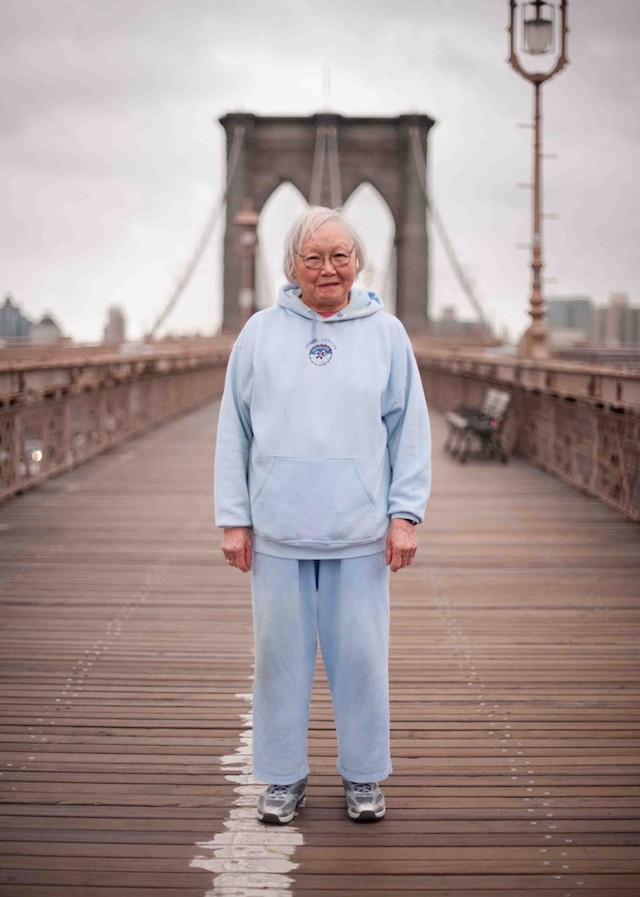
There was a Chinese woman, always dressed in the same sky blue sweat suit, regardless of the weather, who walked to Brooklyn and back. She waved to everyone she passed. There was a Jamaican man who rode his modified moped, cheap radio duck-taped to dashboard, who almost hit and angered everyone he passed. There was Michael, who would walk back to his Cobble Hill home from his night of collecting cans and bottles from the just-closed bars of Manhattan. His tower of cans always seemed close to collapsing, but never did.
As Brooklyn became popular, tourists no longer stopped at the top. They went to Brooklyn for Brooklyn, not just for the view. Then the merchants came, selling sodas, selling sad NYC art, selling whatever other trinkets tourists might want. They clustered near the top, the middle of the walk, turning it into a Brooklynland spin-off of Disneyworld.
If you walk the bridge early or late enough, the tourists and merchants are gone. A few commuters are still there, walking from their homes in Brooklyn to work in Manhattan, or back the other way. At the top, during those empty hours, you can find a rarity in Brooklyn: Solitude.

Chris Arnade received his PhD in physics from Johns Hopkins University in 1992. He spent the next twenty years working as a trader on Wall Street. He left trading in 2012 to focus on photography. His “Faces of Addiction” series explores addiction in the south Bronx neighborhood in New York City.
The American Battlefield
There are many pieces about the murder of Michael Brown by a Ferguson, Missouri, police officer. This one, by Greg Howard at Deadspin, is one of the most wrenching:
Give a man access to drones, tanks, and body armor, and he’ll reasonably think that his job isn’t simply to maintain peace, but to eradicate danger. Instead of protecting and serving, police are searching and destroying.
If officers are soldiers, it follows that the neighborhoods they patrol are battlefields. And if they’re working battlefields, it follows that the population is the enemy. And because of correlations, rooted in historical injustice, between crime and income and income and race, the enemy population will consist largely of people of color, and especially of black men.
Ask Polly: I Think My New Boyfriend Might Be a Horrible Control Freak

Dear Polly,
I started dating a guy a few weeks ago, and yes I know, a few weeks is NOTHING, but, even in that short time some things have come up and I’m having a really hard time separating what is just me being sabotage-y and too fucking sharp, chopping shit up into julienne cuts, and what might be legitimate signs that this is not a good match, which I am overlooking because I am too busy chop chop chopping.
About four years ago, I was in a pretty terrible relationship. He was bipolar, and later on, I found out he lied about pretty much everything: He had a long-term girlfriend, and when he told me that he spent three months in a psych ward where I couldn’t see him, it turns out he was actually living with her. It makes sense now. I pretty much never saw his house (he said he was living with his parents) or most of his world. It was always him in my world. The relationship eventually became abusive, to the point that I was scared for a very long time, stopped sleeping, and finally, swallowed a bottle of pills in front of him in a desperate and stupid attempt to make everything stop.
I moved far, far away, started fresh and created a great life, but it’s left me with a terrible, panicky feeling that all men are hiding something harmful. I can feel myself bracing for the rug to inevitably be pulled out from underneath me.
Since then, I’ve had a few relationships, none of which have really triggered any of this. Until now. With my last significant relationship, we hit things off right away. He lived a ferry ride away, so he’d often come over and stay for a several days, and we’d go off on little trips and adventures. Spending that kind of time with someone felt really good; it felt really secure, and it made me so happy to fall asleep and wake up beside someone I thought the world of.
This new guy, he wants to take things slow. We’ve seen each other quite a bit, and now that it’s been a couple weeks I want to sleep beside this guy. I am not talking about sex. I just mean having him spend the night or me stay with him. I can feel him get weird and flinchy about it, and it really fucks me up. That, and a few little things he does, have started triggering bad memories from my ex, and I am having a really hard time reconciling them. I tried explaining my past and why I am suddenly acting overly analytical and self-sabotaging even though I don’t want to, and now I feel as though I wish I had never told him anything. When I told him that my ex used to force me up against a wall and hold my head while he punched the wall inches from my face, his response was that his ex punched him in the face and broke his nose, but that he’s not projecting that onto me because I’m not her. I get what he’s saying, but it also made me feel diminished and like some sort of fucked up trauma pissing contest was taking place. He used a similar response another time when I told him something heavy after he had asked about it — he said I blindsided him by saying stuff like that — and both times, I walked away feeling really shitty.
Polly, normally I am pretty level headed and decisive and confident in my decisions and know what I want and what I’m about. When I’m with this guy and something comes up, I feel so fucking confused and unsettled and like I should have never said anything. I’m so scared of being mind-fucked again. This guy is really smart, and really good at arguing his points, and it makes my head hurt because I don’t know if I’m just messing it all up because I’m terrified, or if this guy maybe has some serious controlling tendencies because he won’t stay over because he says he’ll only fall asleep if we have sex, but does not want to have sex yet. He also made me feel like I should be more appreciative that he’s let me come over to his house, because even his parents have only been there two or three times in ten years. Am I just spinning in my own insecurities?
Self-saboteuse
Dear Self-saboteuse,
This guy you’re dating is bad news. He’s a control freak and kind of a dick to boot. The fact that he responds to your very personal, vulnerable stories not by listening and empathizing, but by one-upping you with his own traumas and then touting his relative maturity and healthy boundaries AND THEN referring to such sharing as “blindsiding”? These are more than just red flags. They’re warning signals, the way someone walking up to you and setting your hair on fire is a warning signal.
This is a guy who experiences vulnerable, expressive sharing as an assault. He’s four weeks into this thing, and he’s already making it crystal clear he doesn’t want your feelings to come into play. He wants you to feel ashamed of sharing that stuff, so you won’t be tempted to share it again.
What’s really confusing — and what makes you feel insecure, like you’re the source of the trouble here — is that what he says about how he feels about you is completely at odds with how he behaves. He might even be able to plainly and intelligently state his good intentions and proclaim himself healthy, but please trust me, all of that stuff is just him using his intellect to build elaborate scaffolding around aggressive, controlling behaviors that he absolutely fucking refuses to change. He is a smart, arrogant motherfucker who’s building an entire worldview around what he needs and doesn’t need. Guess what he doesn’t need the most of all? You, acting like a fallible human being. Guess what he really, really doesn’t want? You, showing up and telling the truth. What’s truly fucked is that HE WILL SAY THAT HE WANTS THESE THINGS. But you will see, time and time again, that he does NOT want these things. He wants to live in a bubble, safe from other people’s needs and emotions.
To be clear, I’m not even talking about a run-of-the-mill tepid dude, who’s maybe initially flinchy or distant, and then over time either gets less flinchy and falls in love (admittedly somewhat rare) or gets more distant because emotions make him feel awkward or he’s just unsure of what he wants or he knows he’s not all that interested. Tepid dudes might drive you nuts, but they are not necessarily going to make your life a living nightmare. Controlling guys who say one thing and do another are absolute hell, because they act like they’re all in, but at the exact moment when you feel the most raw and sad and flawed, they will trample all over you. They hate weakness, in themselves and others, and they don’t know themselves at all (in spite of what they say about “doing the work” and trying hard to be self-reflective and humble). And your emotions make them feel (wait for it!) BULLIED. Controlling guys act like bullies, but project all of that bullying onto you. They victimize you, and then act like they’re the victims.
I was in a relationship with a control freak a long time ago. He was instantly very into me, and very intense and sure of how he felt. He believed in me. I was amazing. He wanted us to spend tons of time together. And then, when we quickly started to clash, trying to sort it out with him was a fucking NIGHTMARE. If he couldn’t corral a conversation exactly where he wanted it to go, he would become furious and accuse me of controlling him. Everything got turned back on me. Even when I stayed calm and focused on “I” statements, it didn’t help. (He’d say things like, “Did you see what you did there?” as if my emotional experience was just another way of fucking with him.) In his eyes, everything I said or did was manipulative. I couldn’t directly ask him for what I needed. I couldn’t listen and wait and ask later. When I opened up about triggers, when I admitted weaknesses, when I broke down crying out of frustration — all of that only made him more angry. One particular week, he was fixated on how I needed to take responsibility for my own shit and be more vulnerable with him. So I admitted some big insecurities, through tears. His response? Rage. “How did we land here, exactly?” he asked. “And how can I prevent it from happening again?”
The real trap of dating this guy is that he’ll never leave you, as long as he can repeatedly deflect everything and push it back on you, until you’re convinced that YOU have to change and get “better” if the relationship is going to work. This is a sensitive guy who had a very unpredictable upbringing, which, taken alone would be fine. But he dealt with it by controlling his environment, by leaping on top of conversations and controlling them, by developing a seriously rigid outlook on the world. As long as he feels like he’s in control, everything is great. But the second he feels out of control, the world falls to pieces and he’s a totally aggressive, dismissive, awful person.
The trauma pissing match and the lack of empathy and the referring to sharing as “blindsiding” (perceiving emotions as an attack) that you describe — those things are enough to say fuck no to this guy. Because this path leads to ruin. You will feel less and less sure of who you are with him. Your self-esteem will suffer and you will become a pale shadow of your former self. No way. Fuck that.
The refusal to sleep over is its own, separate problem. It fits in with the controlling profile, but it doesn’t necessarily indicate, in a guy who isn’t dismissive and unfair, that there’s no future there. I will say that it does point to someone who’s not that flexible and maybe a little threatened by true intimacy. I have friends who’ve dated guys who disappeared regularly. They have the date of the century, and then the guy insists on 1) not fooling around and 2) going home separately. They’re six months into the relationship, but the guy can’t tolerate hanging out for more than a few hours at a time. And maybe there are women who live this way and match this style perfectly, too. But that sounds pretty bad to me. Men who do stuff like that value their independence more than they value intimacy. Fine for them, not so great for someone who cares a lot about sharing a life.
So look. I know I’m painting a grim picture. To be clear, the guy you’re dating probably has no idea what a controlling guy he is. I’m sure he wants to love and be loved like almost everyone else alive. I’m sure he thinks he has good intentions and feels like he’s just standing up for what he wants. But he has very little humility. He doesn’t know himself well, and he doesn’t really want to know you. He doesn’t want to yield to the wildness of the unknown. He wants to stay safe, stay in control, and stay protected in a carefully constructed, regimented world of his own making.
It doesn’t get better from here, either. Look, you’re already saying “Maybe I’m just overanalyzing this!” I’ve rarely worried that I was overanalyzing a great relationship. Truly great, promising relationships are actually very tough to overanalyze. Because everything is working just fine. There’s nothing to chop chop chop! But when you’re with someone who doesn’t make space for who you are, someone who keeps indicating, in different ways, that he doesn’t want to get to know the full, breathtaking scope of you? That’s a problem. This is someone who is afraid of spontaneity and uncertainty. This is someone who wants to live in a clean, well-lighted cage. This is someone who hates surprises, someone who can’t just let go and see what happens next.
This guy likes you because you’re self-deprecating and you second guess yourself a lot. He’s hoping to control you. THIS MOTHERFUCKER IS BAD NEWS. Even if he’s not punching the wall next to your head in a few months, you’ll be feeling isolated and lonely in his company. Becoming physically and emotionally entangled with someone who feels tortured and assaulted when you tell the truth, and share your past, and/or cry? That’s the definition of wrong. You’d have to hate yourself a lot to walk down that path.
And look, we all have some self-hatred on board. Forgive yourself for falling for this guy. Forgive yourself. I’m sure he’s very charming. You haven’t dated him that long, though, and you know already that this is a big, big problem. Don’t worry that you’re too paranoid. Instead, trust your instincts. I know you don’t want to give up on this. I know you’re thinking of the million and one reasons you shouldn’t bail yet. I know you’re thinking you’ll never find anyone who’s this great. I know you’re worried that you’ll keep running into the same trouble, over and over again.You’re wrong.
You will find someone who loves your wildness, your pain, your past, your ugliness, your flaws, all of it. If you stay vulnerable, if you keep telling the truth about who you are without fear, you will find someone who’s trustworthy enough and strong enough to leap into the unknown with you. You will find someone who isn’t afraid. Forgive this poor guy. He is very fucking afraid.
You are not afraid. If you stay with him, he’ll want you to become smaller and smaller. But you will never be small, so he will never be happy with you. You are big and bright and courageous. You’ll find someone who matches you. Keep the faith. Talk to a therapist, take care of yourself, trust your instincts, and above all, keep the faith, because it’ll happen. Keep being true to yourself, and it will happen.
Polly
Do you grab tree branches so hard that your knuckles turn white and your fingers want to fall off? Write to Polly, and she’ll tell you how to loosen up!
Heather Havrilesky (aka Polly Esther) is The Awl’s existential advice columnist. She’s also a regular contributor to The New York Times Magazine, and is the author of the memoir Disaster Preparedness (Riverhead 2011). She blogs here about scratchy pants, personality disorders, and aged cheeses.
Photo by Adam Brill
Media Horrified By Mirror
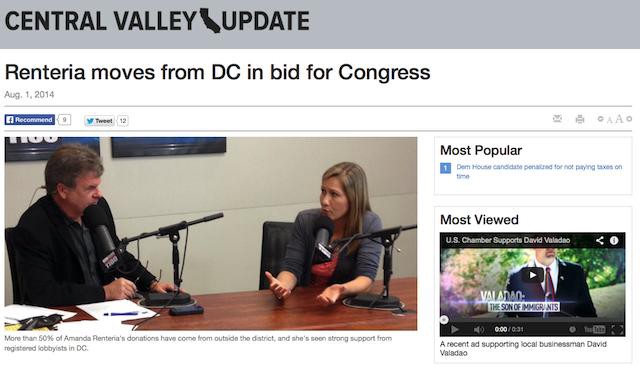
On “fake” fly-by-night news sites as campaign tools:
The NRCC’s single-page sites are designed to appear to be a local news portal, with logos like “North County Update” or “Central Valley Update.” The articles begin in the impartial voice of a political fact-checking site, hoping to lure in readers. “We’ll take a look at her record and let you decide,” starts one. Then they gradually morph into more biting language. At the very bottom, in a box, is the disclaimer that the NRCC paid for the site.
A perfect plan! And unassailable within its horrible context: The intent is to mislead, obviously, but that is true of literally every political ad; the disclosure is present, because it has to be; the “trick” is not totally revealed before the end of the story, where nobody will ever see it, but where everyone agrees, obviously, that people should have seen it, and cetainly they would have seen it, because they read and process everything with reason and rigor; by the time an ideological opponent (your online acquaintance, friend, or family member) notices and comments or emails back saying, “this is and ad designed to look like a story,” it will be too late. Point made, message spread. Why dwell on your mistakes?
Router Bricked

A tiny revelation from James Bamford’s compelling new profile of Edward Snowden in Wired:
One day an intelligence officer told him that TAO — a division of NSA hackers — had attempted in 2012 to remotely install an exploit in one of the core routers at a major Internet service provider in Syria, which was in the midst of a prolonged civil war. This would have given the NSA access to email and other Internet traffic from much of the country. But something went wrong, and the router was bricked instead — rendered totally inoperable. The failure of this router caused Syria to suddenly lose all connection to the Internet — although the public didn’t know that the US government was responsible. (This is the first time the claim has been revealed.)
Well I mean who hasn’t a bricked a router and taken out an entire country’s Internet at least once while trying to update the firmware? The NSA’s “blame Israel” trick is new to me, though.
Music Scene Finds a Way
“I’m outside a strip mall in Stockton, Calif. It’s got a big Asian grocery store, a pet shop, and a secondhand store, called D. Thrift. There are about 50 kids my age — all in their late teens and early 20s — talking and smoking in front of an empty storefront. It used to be a cellphone shop and before that a place that sold diet pills, but tonight it’s the best underground rock show in town.”
Budapest, August 11, 2014

★★ The morning was bright on unfamiliarly lemon-yellow taxis and lime-green sharing bikes. A few clouds were now tempering the glare, making it eye-watering. Long bright green shoots curved up out of the darker topiary cylinders of the treetops running down the median. Indoors, in the music center, bodies overwhelmed the judicious European air conditioning. A low-grade sticky sweat, part humidity and part circadian confusion, rose and lingered. At break time, the light had grown clearer, the zenith open blue. Viewed from the roof deck, upthrust skinny poplar tops waved back and forth beside brown brick chimneys, against a stretch of blue and white. The next quarter, what must have been the west, was gray, with a dull metallic-looking sun lowering behind the clouds. Then the clouds alchemized to gold. The air was drier; a breeze pushed through the picturesque curves of the evening streets. At the open-air restaurant tables on the square outside the basilica, folded blankets sat unused on the chair backs, and the heater cords dangled unplugged. By the time the check came, though, there was almost a chill in the night.
Portrait of an Israeli Peace Protest
by Alex Cocotas
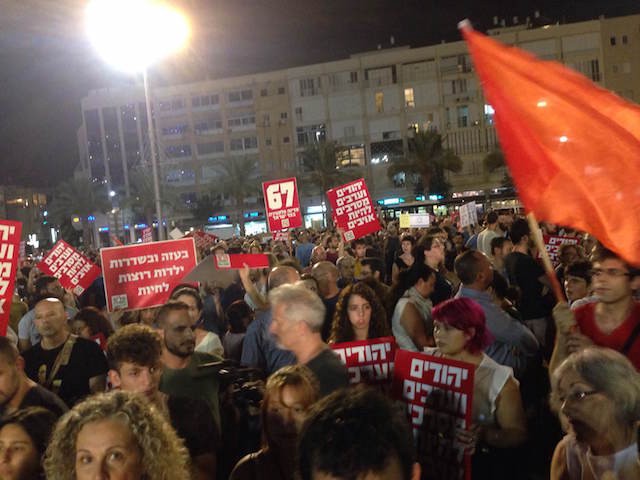
Over the past couple of weeks, a slogan has sought to bridge the gap between the Arab and Jewish communities as the conflict in Gaza has intensified: “Jews and Arabs refuse to be enemies.” As of this writing, its Facebook page has more than sixty thousand likes; participants have posted sixty-six thousand tweets and hundreds of selfies; and it has been greeted in the media with headlines like “Jewish And Arab People Are Posing Together In Inspiring Photos Saying “We Refuse To Be Enemies,” “Jews And Arabs Refuse To Be Enemies — The Powerful Pictures Pushing Peace In Gaza And Israel,” and “Jews And Arabs Refuse To Be Enemies’ Might Be The Movement That Finally Brings Peace.”
However, in the United States, where most of the tweets and pictures seem to originate, “Jews and Arabs refuse to be enemies” is stripped of its political content, context and origin in the Israeli peace movement. (The Israeli peace camp is so small, however, that it might be more accurate to say that it belongs to the Israeli left — not the mainstream Labor party, which has purposefully disassociated itself from the left, or Meretz, the largest left-wing party, which has not forcefully come out against the operation in Gaza — but tiny, Marxist-influenced, Arab-Jewish unity parties, like Hadash or the even smaller Da’am, whose activists typically form the bulk of the sparsely-attended anti-occupation protests within Israel.) In Israel, shouting “Yehudim veAravim m’sarvim l’hiyot oyavim” is not a no-stakes, feel-good slogan; it is a radical political statement that attempts to articulate a different vision for a society whose prevailing forces and voices are wrapped in a rhetoric of violence and fear, lurching from one disaster to the next — and hoping you don’t get hit in the head with a metal pole, or pepper sprayed, or followed home and attacked for doing so. Israel is a country where support for the current operation in Gaza is almost uniform (even the vacancy lights on parking garages blink out “IDF, the people are with you!” intermittently); intermarriage between Jews and Arabs is incredibly difficult as a matter of state policy; there is an active anti-miscegenation movement; peace activists have been repeatedly attacked in recent weeks by right-wing thugs chanting “death to Arabs” and “death to leftists”; and even mentioning the names of Palestinian children killed in Gaza is a “politically controversial” act worthy of censorship.
Two weeks ago, I attended the largest anti-war demonstration since the beginning of the conflict, held in Rabin Square, which plays a central role in the peace movement’s collective imagination. In 1982, four hundred thousand Israelis packed what was then known as Kings of Israel square to protest the war in Lebanon. In 1995, Prime Minister Yitzhak Rabin, the closest thing this country has to a political saint, was assassinated by a right-wing extremist near the square after addressing a rally of a hundred thousand in support of the Oslo Accords. Every year, a memorial rally is held to commemorate his assassination, serving as sort of an annual event for the peace camp. As recently as 2006, a hundred thousand came and heard the writer David Grossman excoriate then Prime Minister Ehud Olmert, who was also on the stage. Last year, approximately thirty thousand people showed up.
Some six thousand Israelis filled Rabin Square to call for an immediate ceasefire. Even before the rally started, the atmosphere felt ominous. Two hours before it was supposed to start, the police abruptly withdrew the rally’s permit and said they would disperse any attempts to continue; the official reason was the threat of rocket fire, even though no rocket has yet landed in Tel Aviv. (The permit was reinstated after organizers said they would proceed anyway.) The demonstrators were young and old, stylish and staid, activists and average people. Some brought their children, others brought their dogs. Upon arrival at Rabin Square, they were funneled into a designated area surrounded by police barriers on the eastern side of the square — to protect them from the five hundred or so right-wing counter-demonstrators, who may or may not be organized by an aging nationalist rapper named “The Shadow.”
The demographics of who was on a given side of the barriers also bore traces of the country’s most significant intra-Jewish conflict, between Ashkenazim and Mizrahim. A significantly higher proportion of the anti-war demonstrators inside the barriers were Ashkenazim — white, European Jews. (The vast majority of American Jews are Ashkenazim.) The majority of Israeli Jews that spoke at the demonstration were Ashkenazi as well — four out of five, I believe. The counter-demonstrators outside, the right-wingers, are predominately Mizrahim, which literally translates to “easterners,” but is used as an imprecise term for Jews from the Middle East. The majority of their grandparents probably spoke Arabic as their first language; their families were deeply ingrained in Arab communities for centuries; and in culture and mannerisms, from the food they eat to the music they listen to, they are much closer to the Palestinians than their Ashkenazim counterparts. Some leftist Mizrahim self-identify as “Arab Jews,” but many Mizrahim would probably find the term pejorative.
Though there had long been an Arabic-speaking Jewish community in historic Palestine that predates Zionism, the majority of Mizrahim arrived in Israel after the establishment of the state — some by choice, others after being expelled from their home country. Upon arriving, many Mizhrai immigrants lived in transit camps, hastily built settlements and tent cities, sometimes for years. Others were bussed directly to what were euphemistically called “development towns,” wretched blocks of Soviet-style apartment blocks on the country’s periphery, sometimes on the false pretense that they were actually being taken to Jerusalem or Tel Aviv. Sderot, the city that has borne the brunt of rocket fire from Gaza, is a development town.
Ever since, Mizrahim have faced systemic discrimination from the Ashkenazi elite who controlled the military, the government, and major cultural organs — the result of their arriving first, living in the most economically desirable areas, and outright racism. David Ben-Gurion, Israel’s founding father,
famously described Mizrahi immigrants
as coming “without a trace of Jewish or human education.” The state, fearing the creeping “Levantization” of Israel, actively tried to strip them of any vestiges of Arabic culture — Mizrahi music was restricted on the radio, for example. David Ben-Gurion, again: “We do not want Israelis to become Arabs. We are in duty bound to fight against the spirit of the Levant, which corrupts individuals and societies, and preserve the authentic Jewish values as they crystallized in the Diaspora” (emphasis mine).
Even today, Mizrahim broadly lag the socioeconomic status of Ashkenazim, have fewer educational opportunities, and their communities receive less government funding. It was Benjamin Netanyahu’s party, Likud, which first cultivated the Mizrahim’s indignation into a political demographic, creating a radical shift in Israeli politics that began with “the revolution” of 1977 — which marked the first time that the right-wing took control of the government, displacing the Ashkenazi-dominated institutional left that had ruled the country since its inception. Significant remnants of those voting patterns still survive today.
The right-wing counter-demonstrators — Jews whose families would likely have been considered Arabs for centuries, now attacking other Jews for chanting “Jews and Arabs refuse to be enemies” — represent an extreme manifestation of the process by which Mizrahi identities were broken, their historic ties to Arabic culture severed and replaced with a unitary Israeli nationalism, fueled by systemic discrimination and government incitement. Today, the Israeli left and the anti-war demonstrators preaching the virtues of peace and chanting “Jews and Arabs refuse to be enemies” are perceived as the political heirs to the perpetrators of the Mizrahim’s cultural subjugation (and, more generally, an indifference to their communities), even though there are plenty of Mizrahim among them — and most of them certainly disapprove of the systematic discrimination against the Mizrahim. While there is, of course, an aspect of generalization to the split — Netanyahu is very much a member of the Ashkenazi elite, there are many Ashkenazi extremist settlers, and just because you are Ashkenazi or Mizrahi does not automatically mark you out as left or right — the division nonetheless underlies the difficulty inherent in realizing the ideals of slogans bellowed from dueling bullhorns as the anti-war demonstrators gathered in the square.
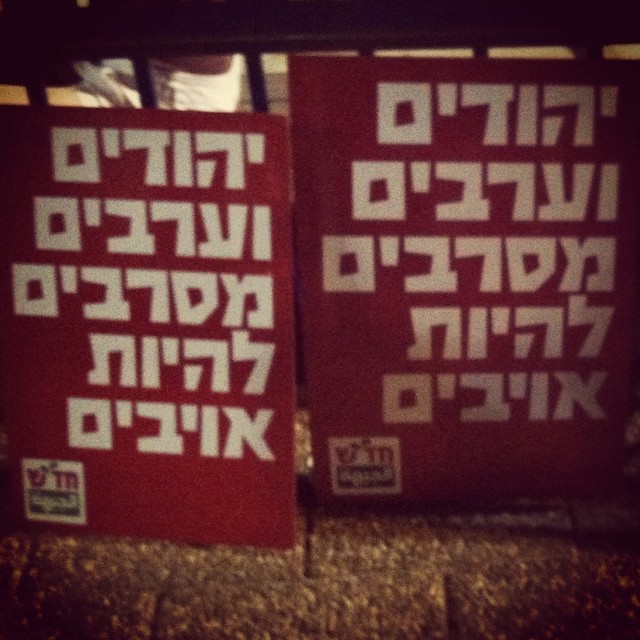
The atmosphere was more somber than other demonstrations I have attended, perhaps because of the more immediate violence, or because it had tipped past that mysterious size when its participants allow themselves to be taken more seriously. We listened to speeches. Some were moving, some were angry, some were boring. I was struck by the inability of several speakers to isolate and identify with the specific suffering of Palestinians in Gaza. The first speaker strained to acknowledge the daily stress of running to bomb shelters under rocket fire, but did not really challenge the audience to empathize with the situation of Gaza’s population, who are being bombed by one of the world’s most powerful militaries — and who don’t have bomb shelters or possibly even have homes to return to. Intermittently, you could hear the chants of counter-demonstrators breaking through the speeches like static on a country road. They chanted things like “School is out in Gaza / they have no children left there.” If you craned your neck to look at the sea of Israeli flags to the right of the stage, then behind you and to the left, you could see the fluttering blue and white looked like a nylon shark that had smelled blood and was slowly circling its prey.
The demonstration ended abruptly when a speech was cut short by a nearby police officer barking orders. We were advised to swiftly exit through the northeast corner of the square and continue north on Ibn Gevirol Street, one of Tel Aviv’s largest thoroughfares, to avoid any problems. According to Haaretz, violence from right-wing counter-protesters prompted the police to ask organizers for the demonstration to be cut short. In other words, a peaceful demonstration of six thousand was prematurely dispersed to appease the violence of five hundred. As we left, the atmosphere was charged. Small arguments and shoving matches started breaking out. I stupidly decided to stay and see what would happen, after convincing myself I could pass as a clueless American on birthright extension if I was confronted. A block north of the square on Ibn Gevriol, right-wing extremists attacked demonstrators, nearly devolving into a full-on brawl at one point, just steps from where Rabin was assassinated. Some tried to attack buses carrying demonstrators back to other cities. For a moment, it looked like it could turn into a riot as police rushed in to intervene. I saw several instances where cops protected individuals from being savagely beaten by the mob of right-wing counter-demonstrators. Despite all this, there were few arrests.
Eventually, the scene quieted down, which is to say all the anti-war demonstrators were driven away. A little while later, I walked back to the square, now mostly empty. Only the right-wing demonstrators remained, chanting and waving the Israeli flag. The police stood to the side, on the edge of the square, drinking water bottles and joking with one another. It was like nothing had happened. There was no evidence that an hour before it had been full of people, asking for peace. A sign I saw at the beginning of the demonstration was depressingly prescient, “תברחו כל עוד אפשר” — flee while you still can. As I read about the protest the next day, I noticed one report that mentioned demonstrators chanted “Jews and Arabs refuse to be enemies.” I can’t help but wonder if someone out there, a member of “Jews and Arabs refuse to be enemies,” an American perhaps, read that and thought to themselves, “Hey, we did it.”
Alex Cocotas is a writer, formerly at Business Insider, who lives in Tel Aviv.

